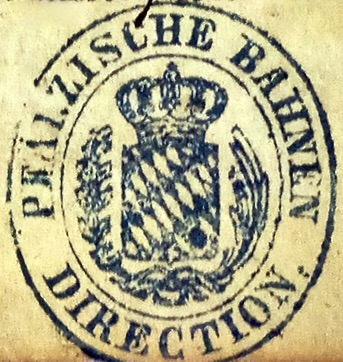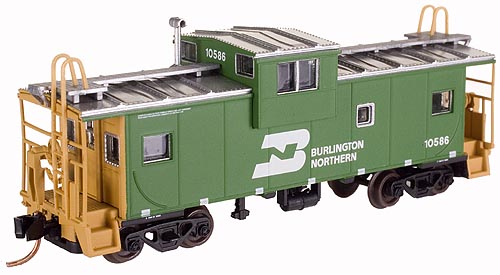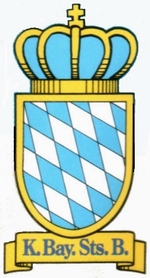Company History: The Palatine Railways (German: Pfälzische Eisenbahnen), often abbreviated to Palatinate Railway (Pfalzbahn) was the name of the railway division and administration responsible for all private railway companies in the Bavarian Palatinate from 1844 to 1908. The railway division was first located in the provincial capital of Speyer and later relocated to Ludwigshafen am Rhein.
The company was inaugurated with the construction of the Palatine Ludwig Railway (Pfälzische Ludwigsbahn) by the eponymous railway company. On the completion of the Palatine Maximilian Railway (Pfälzische Maximiliansbahn) the operational headquarters and management of the Palatine Maximilian Railway Company was also incorporated. In 1862, it was joined by the Neustadt - Dürkheim Railway Company (Neustadt-Dürkheimer Eisenbahn-Gesellschaft). The same happened to the Palatine Northern Railway Company (Gesellschaft der Pfälzischen Nordbahnen) in 1870.
In 1869 all the general shareholders' assemblies approved a merger of the administration, whereby the individual companies remained legally independent and separate books were kept. The shares in the Neustadt-Dürkheim company were taken over by the Northern Railway company on 1 January 1870. At the same time, the three remaining companies received new concessions and a uniform interest rate guarantee.
From 1905 the Bavarian State asserted its right of first refusal. On 1 January 1909, what was then largest private railway company in Germany was renamed as the "Royal Bavarian Railway Division of Ludwigshafen" and incorporated into the Bavarian State Railways. With the end of the monarchy the title "Royal" was dropped. In accordance with the Armistice agreements, the division was taken over by a French field railway unit on 4 December 1918.
The company was inaugurated with the construction of the Palatine Ludwig Railway (Pfälzische Ludwigsbahn) by the eponymous railway company. On the completion of the Palatine Maximilian Railway (Pfälzische Maximiliansbahn) the operational headquarters and management of the Palatine Maximilian Railway Company was also incorporated. In 1862, it was joined by the Neustadt - Dürkheim Railway Company (Neustadt-Dürkheimer Eisenbahn-Gesellschaft). The same happened to the Palatine Northern Railway Company (Gesellschaft der Pfälzischen Nordbahnen) in 1870.
In 1869 all the general shareholders' assemblies approved a merger of the administration, whereby the individual companies remained legally independent and separate books were kept. The shares in the Neustadt-Dürkheim company were taken over by the Northern Railway company on 1 January 1870. At the same time, the three remaining companies received new concessions and a uniform interest rate guarantee.
From 1905 the Bavarian State asserted its right of first refusal. On 1 January 1909, what was then largest private railway company in Germany was renamed as the "Royal Bavarian Railway Division of Ludwigshafen" and incorporated into the Bavarian State Railways. With the end of the monarchy the title "Royal" was dropped. In accordance with the Armistice agreements, the division was taken over by a French field railway unit on 4 December 1918.
Successor/Parent History: The Royal Bavarian State Railways (Königliche Bayerische Staats-Eisenbahnen or K.Bay.Sts.B.) was the state railway company for the Kingdom of Bavaria. It was founded in 1844. The organisation grew into the second largest of the German state railways (after that of the Prussian state railways) with a railway network of 8,526 kilometres (including the Palatinate Railway or Pfalzbahn) by the end of the First World War.
Following the abdication of the Bavarian monarchy at the end of the First World War, the 'Royal' title was dropped and on 24 April 1920 the Bavarian State Railway (Bayerische Staatseisenbahn), as it was now called, was merged into the newly formed German Reich Railways Authority or Deutsche Reichseisenbahnen as the Bavarian Group Administration (Gruppenverwaltung Bayern). The management of the Bavarian railway network was divided into four Reichsbahn divisions: Augsburg, Munich, Nuremberg and Regensburg. The former Palatinate Railway formed the Ludwigshafen division. On 1 October 1933 the only group administration within the Deutsche Reichsbahn-Gesellschaft, the Gruppenverwaltung Bayern, was disbanded.From Wikipedia
Following the abdication of the Bavarian monarchy at the end of the First World War, the 'Royal' title was dropped and on 24 April 1920 the Bavarian State Railway (Bayerische Staatseisenbahn), as it was now called, was merged into the newly formed German Reich Railways Authority or Deutsche Reichseisenbahnen as the Bavarian Group Administration (Gruppenverwaltung Bayern). The management of the Bavarian railway network was divided into four Reichsbahn divisions: Augsburg, Munich, Nuremberg and Regensburg. The former Palatinate Railway formed the Ludwigshafen division. On 1 October 1933 the only group administration within the Deutsche Reichsbahn-Gesellschaft, the Gruppenverwaltung Bayern, was disbanded.From Wikipedia
Brief History: Germany is a Western European country with a landscape of forests, rivers, mountain ranges and North Sea beaches. It has over 2 millennia of history. Berlin, its capital, is home to art and nightlife scenes, the Brandenburg Gate and many sites relating to WWII. Munich is known for its Oktoberfest and beer halls, including the 16th-century Hofbräuhaus. Frankfurt, with its skyscrapers, houses the European Central Bank.
Item Links: We found: 1 different collections associated with Palatinate Railway - Railroad
- Collection N Scale Model Trains: 1 different items.
Item created by: CNW400 on 2022-06-13 17:09:28. Last edited by CNW400 on 2022-06-13 17:09:29
If you see errors or missing data in this entry, please feel free to log in and edit it. Anyone with a Gmail account can log in instantly.
If you see errors or missing data in this entry, please feel free to log in and edit it. Anyone with a Gmail account can log in instantly.








